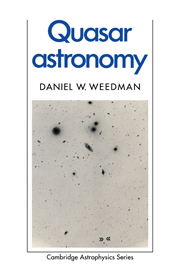5 - Luminosity functions
Published online by Cambridge University Press: 18 December 2009
Summary
Fundamentals of a luminosity function
Understanding the true distribution of objects in space has always been a basic objective of astronomy. Highly sophisticated statistical techniques were developed for determining the distribution of stars in our Galaxy (Trumpler & Weaver 1953). Many of these techniques have recently resurfaced for application to quasars. In many respects, there are great similarities between quasar counting, as done today, and the star counting in the early part of this century that led to an understanding of the structure of our Galaxy. Let us hope that similarly significant results may eventually arise from current quasar surveys. It would be convenient to apply the older techniques directly to quasars, just plugging in a few new numbers. This cannot be done, however. Determining the distributions of interest requires dealing with three dimensions, and the cosmological equations that relate distance for quasars to the observable redshift are much more complex than the euclidean geometry usable by galactic astronomers. Furthermore, quasars are not distributed uniformly in the universe, so statistical techniques based upon homogeneous distributions will not work. Finally, all of the equations of statistical stellar astronomy use magnitude units. This is still the case for most optical astronomy of quasars, but not so for quasar counts based on radio or X-ray observations. So we must deal with the additional complication of discussing both magnitude and flux units. It is necessary, therefore, to build a discussion of ‘statistical astronomy’ for quasars from first principles.
- Type
- Chapter
- Information
- Quasar Astronomy , pp. 93 - 114Publisher: Cambridge University PressPrint publication year: 1986



